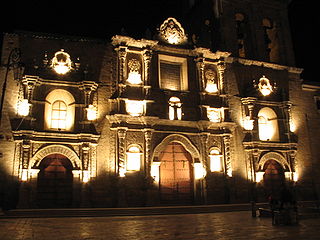
Sucre is the capital city of Bolivia, the capital of the Chuquisaca Department and the sixth most populous city in Bolivia. Located in the south-central part of the country, Sucre lies at an elevation of 2,810 m (9,220 ft). This relatively high altitude gives the city a subtropical highland climate with cool temperatures year-round.
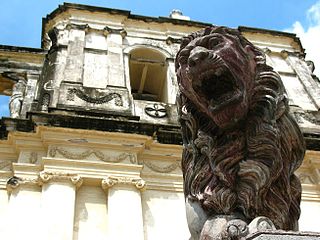
León is the second largest city in Nicaragua, after Managua. Founded by the Spanish as Santiago de los Caballeros de León, it is the capital and largest city of León Department. As of 2022, the municipality of León has an estimated population of 213,718.

Baroque architecture is a highly decorative and theatrical style which appeared in Italy in the early 17th century and gradually spread across Europe. It was originally introduced by the Catholic Church, particularly by the Jesuits, as a means to combat the Reformation and the Protestant church with a new architecture that inspired surprise and awe. It reached its peak in the High Baroque (1625–1675), when it was used in churches and palaces in Italy, Spain, Portugal, France, Bavaria and Austria. In the Late Baroque period (1675–1750), it reached as far as Russia, the Ottoman Empire and the Spanish and Portuguese colonies in Latin America. In about 1730, an even more elaborately decorative variant called Rococo appeared and flourished in Central Europe.

The Basílica Menor of San Francisco de Asís is a Catholic minor basilica and Franciscan convent in the district of Old Havana, Cuba. Its construction began in 1548 and lasted until 1591, although it was inaugurated in 1575, it was badly damaged by storms in 1680 and 1692, and by a hurricane that broke down its tower in 1694. Started in its current form in 1716, it was completely completed almost 200 years later, with a series of structural reforms from 1731 to 1738.

The monumental complex of the Basilica and Convent of San Francisco of Lima, also known as "San Francisco el Grande" or "San Francisco de Jesús", is located in the Historic Center of Lima, Peru. This church together with the Sanctuary Nuestra Señora de la Soledad and the Church del Milagro set up one of the welcoming and artistic corners of Lima. Ramón Menéndez Pidal, Spanish philologist and scholar in this regard commented: "It is the largest and noblest monument that erected in these prodigious lands the conquest".

The Basilica of Santa María de Guadalupe, officially called Insigne y Nacional Basílica de Santa María de Guadalupe is a sanctuary of the Catholic Church, dedicated to the Virgin Mary in her invocation of Our Lady of Guadalupe, located at the foot of the Hill of Tepeyac in the Gustavo A. Madero borough of Mexico City. It belongs to the Primate Archdiocese of Mexico through the Guadalupana Vicariate, which since November 4, 2018, is in the care of Monsignor Salvador Martínez Ávila, who has the title of general and episcopal vicar of Guadalupe and abbot of the basilica.

Ciudad Colonial is the historic central neighborhood of the Dominican Republic's capital Santo Domingo. It is the oldest continuously inhabited European-established settlement in the Americas. The area has been declared a World Heritage Site by UNESCO. It is also known as Zona Colonial or more colloquially as "La Zona".
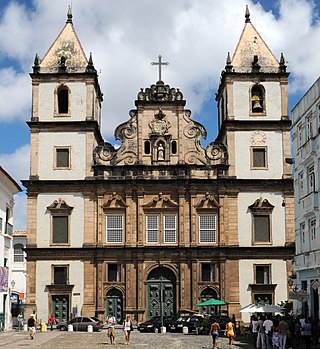
The São Francisco Church and Convent of Salvador is located in the historical centre of Salvador, in the State of Bahia, Brazil. The ornate Church of the Third Order of Saint Francis sits adjacent to the convent. The friars of the Franciscan Order arrived in Salvador in 1587 and constructed a convent and church on the site. This structure was destroyed by the Dutch during the Dutch invasions of Bahia in the next century; Father Vicente das Chagas initiated the current structure in 1686, which was completed in the 18th century. The Franciscan church and convent have the largest number of azulejos, 55,000, of any church in Latin America.
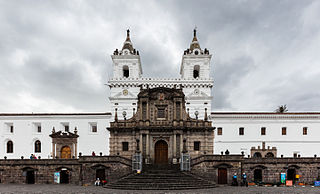
The Basilica and Convent of San Francisco, commonly known as el San Francisco, is a Catholic basilica that stands in the middle of the historic center of Quito, in front of the square of the same name. It is the oldest and most significant religious site in Ecuador. The structure is the largest architectural complex within the historic centers of all of South America, and for this reason it was known as "El Escorial of the New World". San Francisco is considered a jewel of continental architecture for its mixture of different styles combined throughout more than 150 years of construction. San Francisco is part of the UNESCO World Heritage Site "City of Quito".

The Royal Basilica of Saint Francis the Great is a Roman Catholic church in central Madrid, Spain, located in the neighborhood of Palacio.

The Hospital San Nicolás de Bari is a preserved hospital ruin, and it was recognized by UNESCO for being the oldest hospital built in the Americas. Construction began in 1503 in Santo Domingo, Dominican Republic, at the behest of governor Nicolás de Ovando. This grand project was in keeping with the desire to emulate European princely courts, and looked to Renaissance Italy for inspiration. At the time of its completion, the wards could accommodate up to 70 patients, comparable to the most advanced churches of Rome. It is likely that the model for the Hospital de San Nicolás was the large Ospedale di Santo Spirito in Sassia in Rome. The complex forms part of the Colonial Zone of Santo Domingo World Heritage Site.

The Cathedral of Our Lady of the Holy Assumption, better known as Valladolid Cathedral, is a Roman Catholic church in Valladolid, Spain. The main layout was designed by Juan de Herrera in a Renaissance-style.
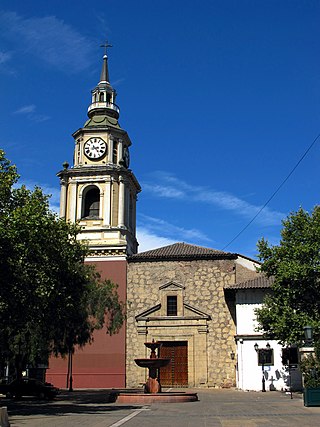
The San Francisco Church is a Franciscan church on Avenida Libertador General Bernardo O'Higgins, in the downtown of Santiago de Chile. The church, along with the adjacent convent, is one of the oldest colonial-era buildings in the country. It has been resistant to about 15 earthquakes of magnitude over 7.

The Peruvian colonial architecture, developed in the Viceroyalty of Peru between the 16th and 19th centuries, was characterized by the importation and adaptation of European architectural styles to the Peruvian reality, yielding an original architecture.

The Basilica and Priory of Nuestra Señora de la Merced is a Roman Catholic church located in Lima, Peru. It was designed in the Baroque style known as Churrigueresque. The church was built under the supervision of Friar Miguel de Orenes in 1535. The Blessed Virgin Mary of Mercy, the patroness of the Peruvian Armed Forces, is venerated in the Basilica. The Mercedarians, who evangelized the region, helped to develop Lima by building many of the churches preserved today.

The Immaculate Conception Church is a Baroque church located in Poblacion, Upper Jasaan in Misamis Oriental, Philippines. It was declared by the National Museum as a National Cultural Treasure in Northern Mindanao due to its artistic design and cultural values.

The Cathedral of Villa Imperial de Potosí or Cathedral of Potosí, the official name is Cathedral Basilica of Nuestra Señora de La Paz is a minor basilica and cathedral with baroque and neoclassical colonial influence. It has a stone facade and is located in Plaza 10 de Noviembre in the center of this Bolivian city of Potosí. It was built between 1809 and 1836 on the site where the old church collapsed in 1807. Its main promoter was the Friar Manuel Sanahuya.

The Iglesia de San Francisco de Paula, Havana is part of the ecclesiastical heritage of Havana. It is located at 110 Calle Leonor Pérez on the corner of Calle San Ignacio. It is near the bay on the south side of Havana Vieja."
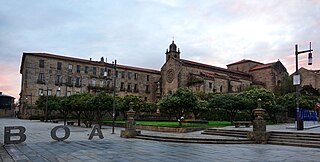
The Convent of St. Francis is a Franciscan convent located in the city centre of Pontevedra (Spain), overlooking the Plaza de la Herrería. The Gothic church of San Francis is attached to the convent on the southeast side.

















